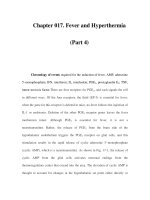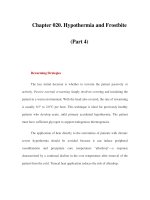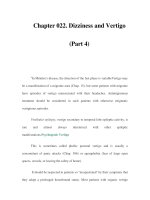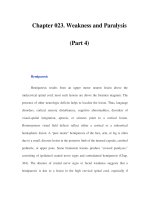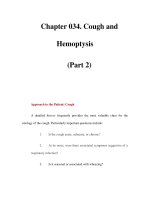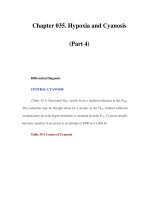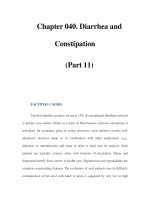Chapter 048. Acidosis and Alkalosis (Part 4) ppsx
Bạn đang xem bản rút gọn của tài liệu. Xem và tải ngay bản đầy đủ của tài liệu tại đây (86.17 KB, 5 trang )
Chapter 048. Acidosis and
Alkalosis
(Part 4)
Approach to the Patient: Acid-Base Disorders
A stepwise approach to the diagnosis of acid-base disorders follows (Table
48-3). Care should be taken when measuring blood gases to obtain the arterial
blood sample without using excessive heparin. Blood for electrolytes and arterial
blood gases should be drawn simultaneously prior to therapy, since an increase in
[HCO
3
–
] occurs with metabolic alkalosis and respiratory acidosis. Conversely, a
decrease in [HCO
3
–
] occurs in metabolic acidosis and respiratory alkalosis. In the
determination of arterial blood gases by the clinical laboratory, both pH and Pa
CO2
are measured, and the [HCO
3
–
] is calculated from the Henderson-Hasselbalch
equation. This calculated value should be compared with the measured [HCO
3
–
]
(total CO
2
) on the electrolyte panel. These two values should agree within 2
mmol/L. If they do not, the values may not have been drawn simultaneously, a
laboratory error may be present, or an error could have been made in calculating
the [HCO
3
–
]. After verifying the blood acid-base values, one can then identify the
precise acid-base disorder.
Table 48-3 Steps in Acid-Base Diagnosis
1. Obtain arterial blood gas (ABG) and electrolytes simultaneously.
2. Compare [HCO
3
-
] on ABG and electrolytes to verify accuracy.
3. Calculate anion gap (AG).
4. Know four causes of high-
AG acidosis (ketoacidosis, lactic acid
acidosis, renal failure, and toxins).
5. Know two causes of hyperchloremic or nongap acidos
is
(bicarbonate loss from GI tract, renal tubular acidosis).
6. Estimate compensatory response (Table 48-
1).
7. Compare ∆AG and ∆HCO
3
-
.
8. Compare change in [Cl
-
] with change in [Na
+
].
Calculate the Anion Gap
All evaluations of acid-base disorders should include a simple calculation
of the AG; it represents those unmeasured anions in plasma (normally 10 to 12
mmol/L) and is calculated as follows: AG = Na
+
– (Cl
–
+ HCO
3
–
). The
unmeasured anions include anionic proteins, phosphate, sulfate, and organic
anions. When acid anions, such as acetoacetate and lactate, accumulate in
extracellular fluid, the AG increases, causing a high-AG acidosis. An increase in
the AG is most often due to an increase in unmeasured anions and less commonly
is due to a decrease in unmeasured cations (calcium, magnesium, potassium). In
addition, the AG may increase with an increase in anionic albumin, because of
either increased albumin concentration or alkalosis, which alters albumin charge.
A decrease in the AG can be due to (1) an increase in unmeasured cations; (2) the
addition to the blood of abnormal cations, such as lithium (lithium intoxication) or
cationic immunoglobulins (plasma cell dyscrasias); (3) a reduction in the major
plasma anion albumin concentration (nephrotic syndrome); (4) a decrease in the
effective anionic charge on albumin by acidosis; or (5) hyperviscosity and severe
hyperlipidemia, which can lead to an underestimation of sodium and chloride
concentrations. A fall in serum albumin by 1 g/dL from the normal value (4.5
g/dL) decreases the anion gap by 2.5 meq/L. Know the common causes of a high-
AG acidosis (Table 48-3).
In the face of a normal serum albumin, a high AG is usually due to non-
chloride-containing acids that contain inorganic (phosphate, sulfate), organic
(ketoacids, lactate, uremic organic anions), exogenous (salicylate or ingested
toxins with organic acid production), or unidentified anions. The high AG is
significant even if an additional acid-base disorder is superimposed to modify the
[HCO
3
–
] independently. Simultaneous metabolic acidosis of the high-AG variety
plus either chronic respiratory acidosis or metabolic alkalosis represents such a
situation in which [HCO
3
–
] may be normal or even high (Table 48-2). Compare
the change in [HCO
3
–
] (∆HCO
3
–
) and the change in the AG (∆AG).
Similarly, normal values for [HCO
3
–
], Pa
CO2
, and pH do not ensure the
absence of an acid-base disturbance. For instance, an alcoholic who has been
vomiting may develop a metabolic alkalosis with a pH of 7.55, Pa
CO2
of 48
mmHg, [HCO
3
–
] of 40 mmol/L, [Na
+
] of 135, [Cl
–
] of 80, and [K
+
] of 2.8. If such
a patient were then to develop a superimposed alcoholic ketoacidosis with a β-
hydroxybutyrate concentration of 15 mM, arterial pH would fall to 7.40, [HCO
3
–
]
to 25 mmol/L, and the Pa
CO2
to 40 mmHg. Although these blood gases are normal,
the AG is elevated at 30 mmol/L, indicating a mixed metabolic alkalosis and
metabolic acidosis. A mixture of high-gap acidosis and metabolic alkalosis is
recognized easily by comparing the differences (∆ values) in the normal to
prevailing patient values. In this example, the ∆HCO
3
–
is 0 (25 – 25 mmol/L) but
the ∆AG is 20 (30 – 10 mmol/L). Therefore, 20 mmol/L is unaccounted for in the
∆/∆ value (∆AG to ∆HCO
3
–
).
